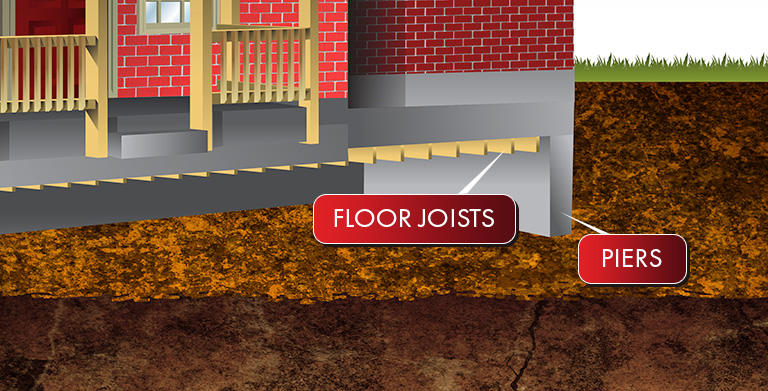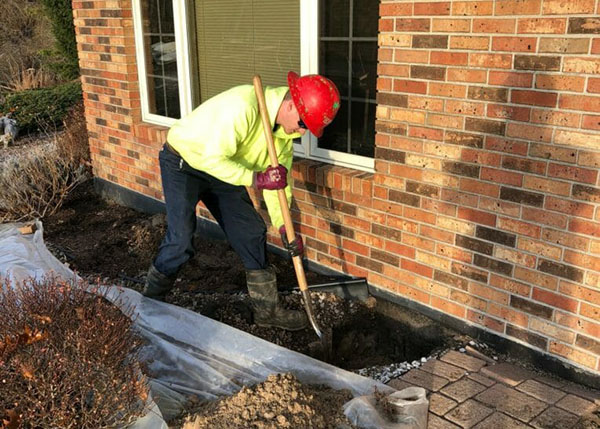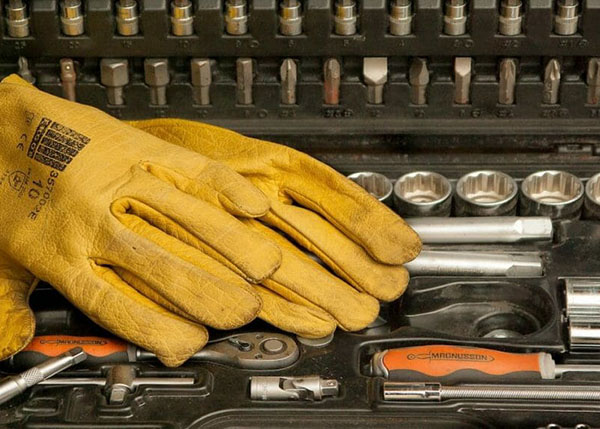Crawl spaces are the second most common type of foundation found throughout Michigan and Ohio. Homes built on a crawl space foundation are usually a bit elevated off the ground (the term crawl space implies there’s enough room to crawl under a house). Crawl space foundations are typically seen on homes that sit on a heavy slope or in flood-prone areas. They can be unfinished or finished (encapsulated) and often house plumbing, electrical, and other “working” elements of a home. The base of a crawl space must sit underneath the frost line, which in Michigan and Ohio, is usually about 42” below ground.

Signs Your Crawl Space Foundation Needs Repair
Crawl space foundation problems commonly show up elsewhere on the house. Unfinished crawl spaces are prone to some additional issues that slab foundations are not. If you see any of these symptoms, request a free foundation evaluation and quote.
- A musty smell in your crawl space or coming from your first floor
- Standing water or flooding in your crawl space
- Mold, rot, or mildew in your crawl space (note: dry rot is NOT visible on the outer parts of wood)
- Increase of allergies, asthma symptoms, or chronic respiratory infections among your family (an increase in these health hazards can be a result of mold and mildew in your crawl space)
- Cracks in the visible parts of your foundation
- Cracks on exterior or interior walls
- Sagging, sloping, or cracked floors
- Chimney [links to: Chimney Repair detail page] that is leaning (out or in), separating, or sinking
- Gaps or separation around windows and doors
- Windows and doors that have started sticking or have become difficult to open or close

What Causes Crawl Space Foundation Problems?
Similar to slab foundations, water and soil are the main culprits behind issues with crawl space foundations.
Even though crawl spaces tend to have better air and water flow underneath them compared to a slab foundation, improper grading and drainage can still cause water to pool under and around them. When the temperature is above freezing, the soil expands when wet and shrinks when it dries, creating constant movement. When we hit winter, the wet ground freezes, usually unevenly, pushing up and against sections of the crawl space. This uneven pressure causes uneven strain on the entire foundation.
Additionally, poor drainage can create excessive moisture under the home, which can damage the wood, beginning with the beams. Issues like rot, mold, and disintegration can start, and because of the interconnected nature of a crawl space foundation, one bad section of wood can easily have a negative compounding effect.
Expansive clay soils are common throughout Michigan and Ohio and are a common cause of foundation problems. As the name implies, these soils expand 10% or more when they get wet, and drastically shrink when they dry out. This constant expanding and contracting causes crawl space foundations to settle and shift at an uneven rate, compromising the stability.

Crawl Space Foundation Repair Method
Here at Kent Foundation Repair, we rely on helical piers, also called helical piles, to bring a crawl space foundation back to level.
Helical piers look, act, and are installed like giant screws. They have plates on top that attach under an existing foundation, and transfer the weight of your home to the steel pier, securely anchoring your home and providing strength.
How Helical Piers are Installed on a Crawl Space Foundation
- Holes are dug at each location where a helical pier will go. The holes are deep enough to expose the footing (base) of the foundation.
- Steel L-shaped brackets are placed under the footing.
- Helical piers are then driven into the ground until they reach appropriate load-bearing soils.
- The weight of your home is shifted to the helical piers using hydraulic jacks.
- The crew attempts to close any floor or wall cracks as they level your home. Please note: the goal is to level the foundation. Closing cracks and other cosmetic fixes is a secondary goal and not guaranteed.
- Any excavated soil is filled back in to cover the brackets and helical piers.
More Helpful Information
Additional resources for homeowners with crawl spaces.
Crawl Space Foundation Repair Frequently Asked Questions
How much does crawl space foundation repair cost?
The cost to repair a crawl space foundation can vary depending on the size of your house, the condition of your current foundation, and more. To get a solid idea of cost, request a free evaluation and estimate.


